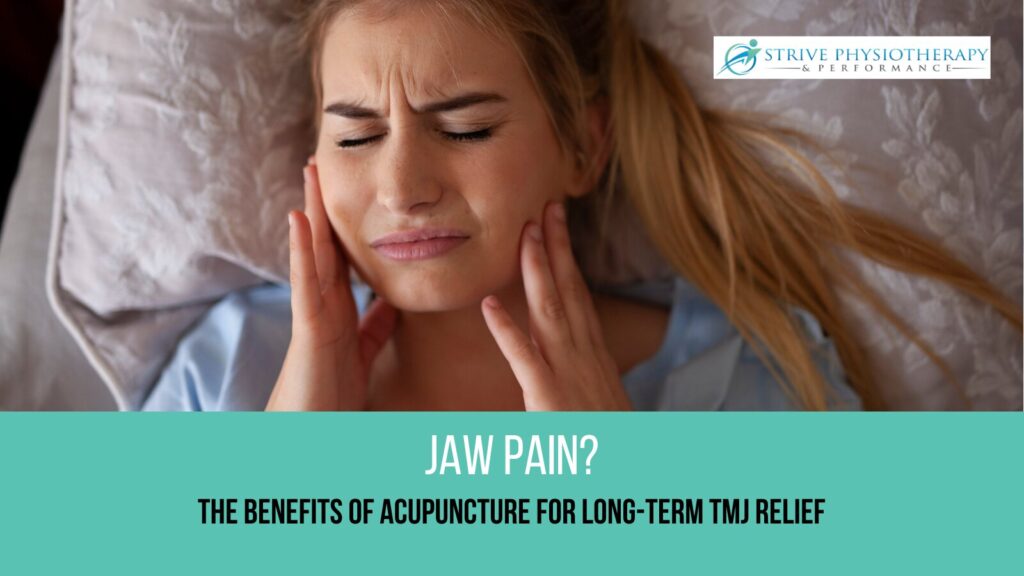
Did you know that 5-12% of the population experience TMJ pain? Let’s explore some pain relief options to relieve your TMJ.
Does Acupuncture Help TMJ Pain?
Acupuncture can help TMJ (temporomandibular joint) pain, or pain in your jaw. People with TMJ disorders may experience jaw pain from clenching, including at night time or during the day time due to habits or stress. They may experience jaw pain with eating, talking, yawning, or other activities that use jaw motion.
Acupuncture creates microtrauma in the area where the needle is placed, which drives an increase in blood flow as part of the healing response. This can result in decreased tension in tense muscles around the jaw, providing pain relief. There also can be an endogenous opioid response, which are natural pain killers that are released in response to an acupuncture treatment.
What Acupuncture Points Are Used for TMJ Pain?
Acupuncture points locally in your TMJ area like ST7, or locally in the TMJ muscles like Taiyang may be used to directly target the TMJ and the TMJ muscles.
Acupuncture points in the surrounding area of your neck like GV14, GB 20 or GB 21 may be used to promote neck relaxation and improve comfort with sitting with a tall posture. This assists with comfortable jaw function.
Acupuncture points distally away from the area of your pain like in your hand at Li4 may be used for pain relief in some cases.
How Long Does It Take for Acupuncture To Work for TMJ?
You may experience pain relief from acupuncture for your TMJ after the first visit. You may require further treatments 1-2x/week to continue experiencing pain relief.
How Can I Permanently Relieve TMJ Pain?
To permanently relieve TMJ pain, you will likely need to address the root cause of the pain or dysfunction.
This may include examining your habits and determining the best ways to reduce the excess load on your jaw. This may include addressing habits like resting your jaw on your hand for prolonged periods, slumped positions while eating, or repetitive gum chewing.
Relaxation techniques can also be helpful in patients who find stress/anxiety aggravates their TMJ symptoms or contributes to excess muscle tension. Home self-management strategies like self-massage and heat therapy can relieve pain on a day-to-day basis.
Exercise therapy can be an important part of permanent TMJ pain relief. Some people will need to work on a range of motion exercises for their jaw to improve their jaw opening or closing mobility. Some people may need to work on jaw strengthening to improve the function of the muscles that move the jaw. Range of motion and strengthening exercises for the surrounding muscles and joints like the neck, scapula, and shoulders may be needed as well to optimize the function of the jaw.
The best way to know what specific exercises to do is to have an assessment with a physiotherapist who will be able to assess your neck, scapula, shoulder, and jaw function and provide you with the appropriate exercises based on your signs and symptoms.
What Massage Is Best for TMJ?
Massage therapy can be used to provide TMJ pain relief. This will include massage to the surrounding jaw muscles, to promote relaxation, flexibility, and optimal function. This will include the muscle in your temples called temporalis, the muscle that runs from the cheekbone to the angle of your jaw bone (mandible) called masseter, and other smaller jaw muscles like the pterygoids or buccinator.
Massage therapy in the surrounding neck muscles, including underneath your skull at your suboccipital muscles, can also be helpful to reduce jaw pain by optimizing neck flexibility and function. Depending on the flexibility of your thoracic spine, and shoulders, massage therapy may be helpful in these areas as well to allow for a tall sitting posture while eating.
Final Words
Don’t settle for less and allow yourself to live with TMJ pain. Book an appointment with one of our expert physiotherapists today for an individualized treatment plan.
We can help you with a wide range of common conditions including neck pain, sports injuries and joint pain to name a few.